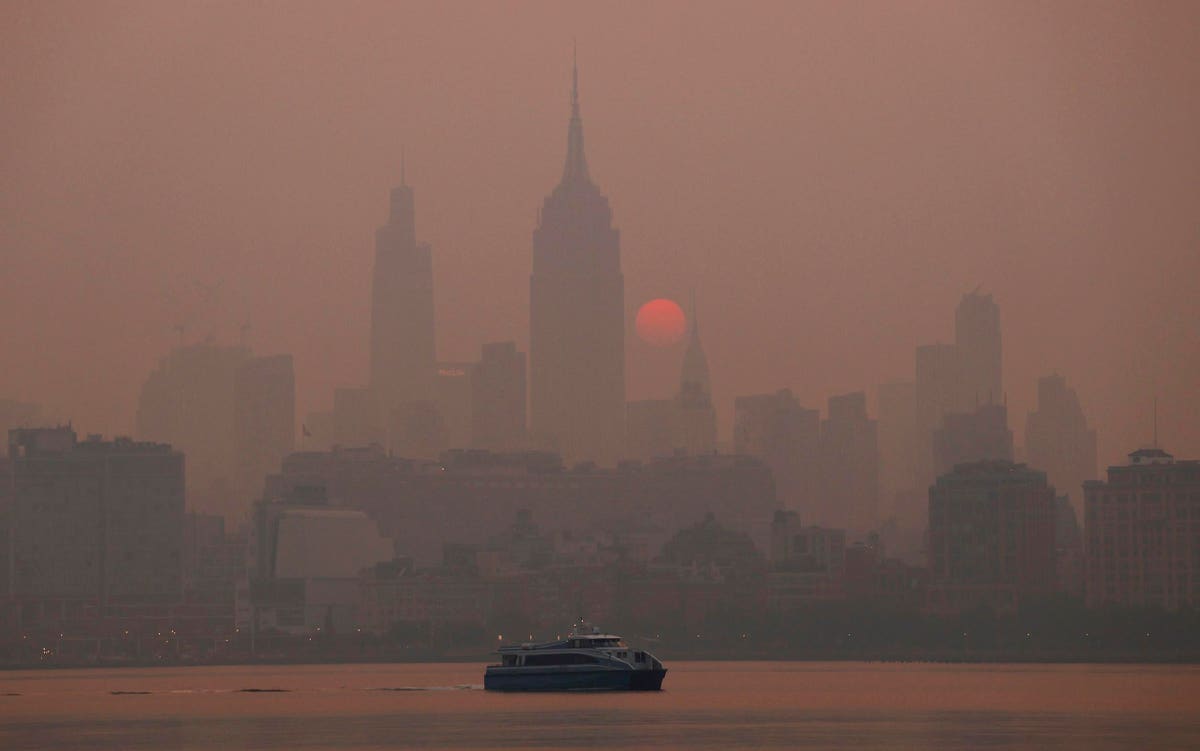Current Climate: Wildfires Are Damaging The Quality Of The Air Leave a comment
This week’s Current Climate, which every Saturday brings you the latest news about the business of sustainability. Sign up to get it in your inbox every week.
The sun is shrouded as it rises in a smokey sky behind the Empire State Building, Chrysler Building and One Vanderbilt in New York City on June 8, 2023, as seen from Jersey City, New Jersey.
Getty Images
The biggest environmental story of the week was easily the ongoing wildfires in Canada, whose smoke drifted into the northeast United States, temporarily making New York City the most polluted city on the planet. This has had extraordinarily disruptive consequences, such as plane reroutes and cancellations, forcing schools to go remote and postponing baseball games. People on the west coast are more accustomed to these air quality issues, but the East coast has rarely seen the likes of this since the Clean Air Act forced industry to clean up pollution and smog.
As I write this, things are starting to let up–but that may only be temporary. Canada’s wildfires are expected to impact the U.S. all summer. So if you’re not familiar with what the various colors in the air quality index mean, check out this guide. Oh, and if you still have some N95 masks laying around the house from the peak of the pandemic, go ahead and break them out: they’ll help out your lungs if you have to spend a significant amount of time outside in smoky skies. Here are some more tips for staying safe on bad air quality days as well.
The Big Read
Getty Images
First Major U.S. Wind Farm Construction Begins Off Massachusetts—And More Are Coming
Construction of the initial turbines in the first major U.S. offshore wind farm began this week south of Martha’s Vineyard off the coast of Massachusetts, following a years-long legal battle and a series of federal slow-downs over the controversial project—part of the Biden Administration’s push for green energy and the first in a wall of offshore wind projects off the East Coast.
Discoveries And Innovations
Scotch distiller Arbikie aims to go completely green by using wind power to make hydrogen, which will in turn power its facility.
A new study from the American Lung Association estimates that transitioning to zero emission cars in the United States could save 90,000 lives, generate $978 billion in public health benefits and lead to 2.2 million fewer asthma attacks.
Autodesk is providing pro bono support to Coral Maker, which is using 3D printing technology to help restore coral reefs at scale.
NextWave Plastics is estimating that it’s diverting the equivalent of 32 million plastic water bottles from being dumped in the ocean every year.
Sustainability Deals Of The Week
Alternative Fuel: Ammonia fuel startup Amogy has concluded its series B round with an $11 million series B-2 extension, bringing the total round to $150 million.
Nuclear Fusion: The U.K. government recently awarded over $8.5 million worth of contracts to organizations focused on fusion power development.
Carbon Removal: Charm Industrial, which is developing biological methods of sequestering carbon, announced it raised a $100 million series B round led by General Catalyst.
On The Horizon
Atmospheric carbon dioxide levels reached an all-time record high last month, after growing at one of the fastest rates on record. And the increase doesn’t show any signs of slowing down at the moment. This doesn’t bode well for controlling the rapid change of the world’s climate, especially as heat levels in the ocean appear to be rising to the point that it can no longer serve as a “heat sink” for the atmosphere. This will have impacts across the planet, not only from rising temperatures, but from the carbon dioxide itself. Increased carbon dioxide in the atmosphere also increases it in the oceans, making it more acidic and disrupting the life cycles of fish and plants–including those people use for food. Increasing atmospheric carbon dioxide reduces the nutrients in crops humans depend on as well.
What Else We’re Reading This Week
Satellite beams solar power down to Earth, in first-of-a-kind demonstration (Science)
As insurers cut coverage because of climate change, they invest in fossil fuels (Washington Post)
Green Transportation Update
POOL/AFP via Getty Images
Mercurial billionaire Elon Musk reclaimed his ranking as the richest person on earth last week, wrestling the title away from LVMH chairman Bernard Arnault, as shares of Tesla, Musk’s electric vehicle giant, surged to its highest level this year. Tesla gained again on Friday after General Motors said it had a deal for its EV customers to use Tesla’s charging stations, following a similar deal by Ford.
The Big Transportation Story
getty
Here’s How To Get The $7,500 Electric Car Credit On A Vehicle That’s Otherwise Excluded
Though only a handful of EVs officially qualify for a $7,500 federal tax credit, mainly those made in North American plants with locally sourced components and materials, some automakers are leveraging a loophole in the legislation. BMW, Genesis, Hyundai, Kia and a few brands have found that their customers can take advantage of the credit via leasing programs.
More Green Transportation News
Will JLR Maintain Profitability As Electrification Hurdle Looms?
America’s Long, Tortured Journey to Build EV Batteries (Bloomberg)
Lightning eMotors Bets On Government Bucks To Sell Its Electric School Buses
Tesla Model 3 Refresh ‘Project Highland’ Spied, May Signal Release
Tesla Model 3 Now Among Cheapest EVs With Price Cut And Tax Credit



